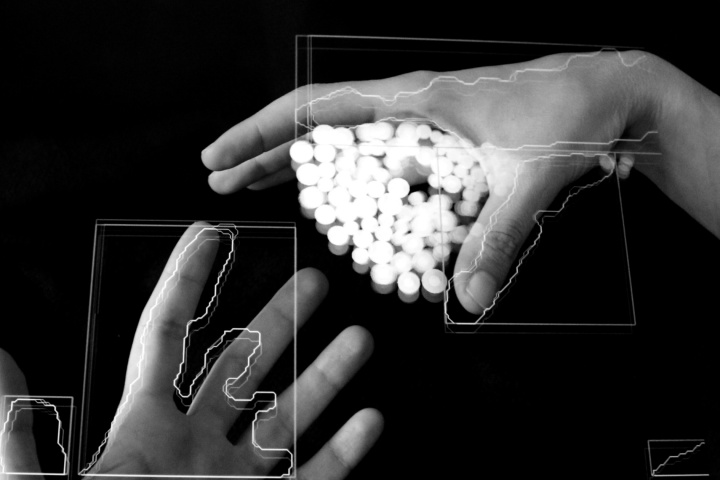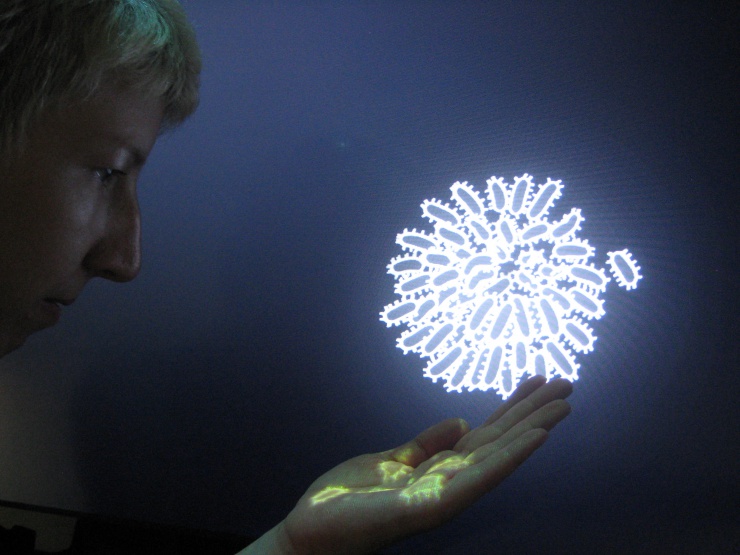BASE 8 is a system that examines the negative spaces between fingers and the motion of hands and arms. Moving structures and abstract geometric forms begin to appear in between fingers or grow out from the hands and arms creating a reactive organic environment.

Vsebina
The Spaces In-between
There is no definite boundary between real and virtual space that would inform the human brain when it perceives the difference between the material world and the world of illusion. The eye’s pupil is left to a strange set of coincidences that are only partially dependent on the physical properties of the materials. Perception is constantly altered by distractions and deformations that arise from the extremely flexible characteristics of the eye which sharpens and then blurs the viewed object. Each new experience triggers a set of associations, memories, and learned categorisation systems.
The artist and programmer Chris Sugrue develops interactive installations, audio-visual performances and experimental interfaces through which she explores the field of virtual reality in relation to the phenomenology of the body. Her interactive installation BASE 8 is, as she puts it: “a system that examines the negative spaces between the fingers and the motion of the hands and arms.” She came to the idea of working with negative space – in the geometrical sense not as an antonym of the positive space – while thinking about the numeric bases for counting systems which vary in different linguistic structures. How can we think about our world outside of the binary field of ones and zeros, count without using the decimal system, or consider the duodecimal counting system used by ancient civilizations? BASE 8 is inspired by languages that developed the octal numeric base by counting the spaces in-between the fingers rather than the body mass itself. What changes in our consciousness when we observe the reverse space, when materiality becomes insignificant, when we focus our gaze in a different way than the one we are used to?
The installation BASE 8 is a generative environment reminiscent of a hologram. However, the projection is not three-dimensional even though perceptively it comes relatively close to it. When constructing her installation the artist adopted a 19th century optical illusion called “Pepper's Ghost” which uses translucent glass screens that function as deflective mirrors for enacting eerie scenes in illusionist tricks. Sugrue has adjusted the old theatrical trick and installed tinted glass at a right angle, so that the projection from an LCD monitor is deflected onto our hands. A depth-sensing camera is used to detect the position and distance of the hands. Software written in C++ analyses the video image, detects the contour of the hand and locates the space between the fingers. The generated animation projected on the two-dimensional plane adjusts to the mapping of these in-between spaces and follows the physical movements. The software also calculates the depth of the moving object and defines the centralised gravitational pull of the “moving structures and abstract geometric forms that begin to appear in-between the fingers or grow out from the hands and arms thus creating a reactive organic environment.”
The work of Chris Sugrue is defined by clean, minimalist aesthetics and intertwined organic shapes that are a result of tracking programs and algorithms for animated visuals. She projects abstract light forms with subtle digital elements to which the body reacts with playful fascination. The hands are one of the central motifs in the artist's interactive installations – they are one of the first parts of the body that activate the consciousness of oneself. The hands also play an important role in nonverbal language, which often reveals more about a speaker than one’s actual words. Sugrue is fascinated by the amazing adaptability of the human brain and its subsequent perception as it faces optical loops. During her investigative process the artist came across some remarkable results from psychological experiments that had researched the brain-body relation. Tests have shown that in certain circumstances people recognise a fake limb as their own – they feel pain, cold, heat – if their arm is hidden behind a screen or mirror. In her installation the synthesis of the transition between the digital and organic world initiates a tangible sense of augmented reality. However, the transition into the virtual space is not invasive as can be the case with three-dimensional simulations that might overwhelm the entire spectrum of senses; rather, it is much more delicate and nonthreatening. The digital dust spills into the space between the fingers like a subtle extension or an appendage. The magical moment occurs through the contact with the augmented reality of one's own body.
Text by Ida Hiršenfelder
With the assistance of Chris Sugrue, Ljudmila's artist-in–residence.
About the artist
Chris Sugrue holds a Masters of Fine Arts in Design and Technology from Parsons School of Design. She has exhibited internationally in such festivals and galleries as Ars Electronica, Sónar Festival, Pixel Gallery, Medialab-Prado, Matadero Madrid, and La Noche En Blanco Madrid. Her interactive installation, Delicate Boundaries received an honorary mention from Vida Art and Artificial Life Awards and first prize from Share Festival. In 2009, she collaborated to help develop the EyeWriter , a low-cost eye controlled drawing tool for ALS patients. The EyeWriter was honored with Design of the Year award for interactive category, the Future Everything Award, and a Golden Nica from Ars Electronica. Chris has worked as a creative engineer at the Ars Electronica Futurelab where she was the lead interaction developer for a stereoscopic interactive dance performance with artist and choreographer Klaus Obermaier. She was the recipient of a year-long fellowship at the Eyebeam Art and Technology Center in New York, and has held artist residencies with Hangar in Barcelona, La Casa De Velázquez in Madrid and Harvestworks in New York. She has also taught courses in the Design and Technology department at Parsons School of Design, the Interface Culture program at the KunstUniversitat in Linz, Austria, and numerous workshops on visual and creative programming.
Digital Dish @ Ljudmila: Chris Sugrue: Artist Talk
Thursday, May 26, 6 pm, 2011 at Mestna galerija Ljubljana
 Chris Sugrue is an artist and programmer developing interactive installations, audio-visual performance and experimental interfaces. Her works experiment with technology in playful and magical ways sometimes exploring themes of the real versus the virtual and investigating topics such as artificial life, eye-tracking and electromagnetics. Chris works both individually as an artist as well as on collaborative projects, and actively teaches in the area of visual and creative programming.
Chris Sugrue is an artist and programmer developing interactive installations, audio-visual performance and experimental interfaces. Her works experiment with technology in playful and magical ways sometimes exploring themes of the real versus the virtual and investigating topics such as artificial life, eye-tracking and electromagnetics. Chris works both individually as an artist as well as on collaborative projects, and actively teaches in the area of visual and creative programming.
Chris will speak about her past works in new media art and her working process as both a coder (in c++!) and visual artist.
BASE 8 was developed by Chris Sugrue at Ljudmila´s Artist in Residence program (16 May – 11 July 2011).
Production: LJUDMILA, Ljubljana Digital Media Lab at KUD France Prešeren Trnovo
Co-production: KIBLA
Location: KiBela/KIBLA (Ulica kneza Koclja 9, Maribor)
EXHIBITION: Monday, 4th July at 8 PM until 14 July 2011
KIiBela, space for art, is open daily from Monday to Friday between 9 AM and 10 PM, Saturday from 4 PM – 10 PM and closed Sundays.
